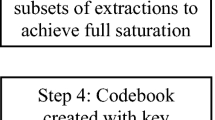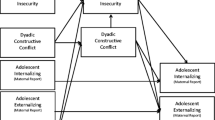Abstract
There are currently almost no treatment efforts to reduce parent–adolescent conflict in adolescents with ADHD. As such, this study investigated the effect of an intensive Summer Treatment Program for Adolescents with ADHD (STP-A) on parent–adolescent conflict. Twenty adolescents and their parents completed the 8 week behavioral treatment program, which included 320 hours of adolescent-directed treatment, 15 hours of parent behavior management training, and daily feedback from staff on parent implementation of a home-based behavioral contract. Results indicated that 70–85 % of adolescents who attended the STP-A demonstrated reliable improvement in parent–adolescent conflict from baseline to post-treatment. Treatment response was associated with higher levels of conflict at baseline, but not adolescent ODD severity or parent ADHD severity. Several patterns of treatment non-response were detected through visual examination of weekly conflict scores during the STP-A. Discussion suggests that intensive, parent-involved treatment programs may be necessary to improve home-conflict in adolescents with ADHD.
Similar content being viewed by others

References
Adler, L. A., Spencer, T., Faraone, S. V., Kessler, R. C., Howes, M. J., Biederman, J., et al. (2006). Validity of pilot adult ADHD self-report scale (ASRS) to rate adult ADHD symptoms. Annals of Clinical Psychiatry, 18, 145–148.
American Psychiatric Association. (2000). Diagnostic and statistical manual of mental disorders (4th ed-TR). Washington, DC: Author.
Anderson, J. C., Williams, S., McGee, R., & Silva, P. (1987). DSM-III disorders in preadolescent children. Archives of General Psychiatry, 44, 69–76.
Atkins, D. C., Bedics, J. D., Mcglinchey, J. B., & Beauchaine, T. P. (2005). Assessing clinical significance: does it matter which method we use? Journal of Consulting and Clinical Psychology, 73, 982–989.
Babinski, D. E., Pelham, W. E., Molina, B. S. G., Gnagy, E. M., Waschbusch, D. A., Wymbs, B. T., et al. (2012). Maternal ADHD and psychosocial functioning of mothers of adolescents with ADHD. Journal of Attention Disorders.
Barkley, R. (2004). Adolescents with attention-deficit/hyperactivity disorder: an overview of empirically based treatments. Journal of Psychiatric Practice, 10, 39–56.
Barkley, R., Fischer, M., Edelbrock, C., & Smallish, L. (1990). The adolescent outcome of hyperactive children diagnosed by research criteria: I. An 8-year prospective follow-up study. Journal of the American Academy of Child & Adolescent Psychiatry, 29, 546–557.
Barkley, R. A., Anastopoulos, A. D., Guevremont, D. C., & Fletcher, K. E. (1992a). Attention deficit hyperactivity disorder in adolescents: mother-adolescent interactions, family beliefs and conflicts, and maternal psychopathology. Journal of Abnormal Child Psychology, 30, 263–288.
Barkley, R. A., Guevremont, D. C., Anastopoulos, A. D., & Fletcher, K. E. (1992b). A comparison of three family therapy programs for treating family conflicts in adolescents with attention-deficit hyperactivity disorder. Journal of Consulting and Clinical Psychology, 60, 450–462.
Barkley, R. A., Edwards, G. H., & Robin, A. L. (1999). Defiant teens: A clinicians manual for assessment of family intervention. New York: Guilford Press.
Barkley, R., Edwards, G., Laneri, M., Fletcher, K., & Metevia, L. (2001). The efficacy of problem-solving communication training alone, behavior management training alone, and their combination for parent–adolescent conflict in teenagers with ADHD and ODD. Journal of Consulting and Clinical Psychology, 69, 926–941.
Biswas, A., Gnagy, E, Molina, B., & Pelham, W. (2009). Examining the decline of treatment usage in adolescents with Attention Deficit Hyperactivity Disorder. Poster presented at the annual meeting of the Association for Behavioral and Cognitive Therapies, New York, NY.
Botvin, G. J. (2004). Life skills training: Middle school. White Plains: Princeton Health Press.
Cantwell, D. P. (1986). Attention deficit disorder in adolescents. Clinical Psychology Review, 6, 237–247.
Cohen, J. (1988). Statistical power analysis for the behavioral sciences (2nd ed.). Hillsdale: Erlbaum.
Edwards, G., Barkley, R., Laneri, M., Fletcher, K., & Metevia, L. (2001). Parent–adolescent conflict in teenagers with ADHD and ODD. Journal of Abnormal Child Psychology., 29, 557–572.
Evans, S. W., Vallano, G., & Pelham, W. (1994). Treatment of parenting behavior with a psychostimulant: a case study of an adult with attention-deficit hyperactivity disorder. Journal of Child and Adolescent Psychopharmacology, 4(1), 63–69.
Evans, S., Pelham, W., Smith, B., Bukstein, O., Gnagy, E., Greiner, A., et al. (2001). Dose–response effects of methylphenidate on ecologically valid measures of academic performance and classroom behavior in adolescents with ADHD. Experimental and Clinical Psychopharmacology, 9, 163–175.
Evans, S. W., Sibley, M. H., & Serpell, Z. N. (2009). Changes in caregiver strain over time in young adolescents with ADHD. Journal of Attention Disorders, 12, 516–524.
Fabiano, G. A., Pelham, W. E., Waschbusch, D. A., Gnagy, E. M., Lahey, B. B., Chronis, A. M., et al. (2006). A practical measure of impairment: psychometric properties of the Impairment Rating Scale in samples of children with attention deficit hyperactivity disorder and two school-based samples. Journal of Clinical Child and Adolescent Psychology, 35, 369–385.
Farrell, A. D., & White, K. S. (1998). Peer influences and drug use among urban adolescents: family structure and parent–adolescent relationship as protective factors. Journal Of Consulting And Clinical Psychology, 66, 248–258.
Fischer, M., Barkley, R., Fletcher, K., & Smallish, L. (1993). The stability of dimensions of behavior in ADHD and normal children over an 8-year followup. Journal of Abnormal Child Psychology, 21, 315–337.
Fletcher, K. E., Fischer, M., Barkley, R. A., & Smallish, L. (1996). A sequential analysis of the mother–adolescent interactions of ADHD, ADHD/ODD, and normal teenagers during neutral and conflict discussions. Journal of Abnormal Child Psychology, 24, 271–297.
Hsu, L. M. (1999). Caveats concerning comparisons of change rates obtained with five methods of identifying significant client changes: comment on Speer and Greenbaum (1995). Journal of Consulting and Clinical Psychology, 67, 594–598.
Jacobson, N. S., Roberts, L. J., Berns, S. B., & McGlinchey, J. B. (1999). Methods for defining and determining the clinical significance of treatment effects: description, application, and alternatives. Journal of Consulting and Clinical Psychology, 67(3), 300–307.
Johnston, C., & Mash, E. J. (2001). Families of children with Attention-Deficit/Hyperactivity Disorder: Review and recommendations for future research. Clinical Child And Family Psychology Review, 4, 183–207.
Kazdin, A. E. (1977). Assessing the clinical or applied importance of behavior change through social validation. Behavior Modification, 1, 427–452.
Larson, R. W., Richards, M. H., Moneta, G., Holmbeck, G., & Duckett, E. (1996). Changes in adolescents’ daily interactions with their families from ages 10 to 18: disengagement and transformation. Developmental Psychology, 32, 744–754.
Laurensen, B., Coy, K., & Collins, A. (1998). Reconsidering changes in parent–child conflict across adolescence: a meta-analysis. Child Development, 69, 817–832.
Mannuzza, S., Gittelman-Klein, R., Bessler, A., Malloy, P., & LaPadula, M. (1993). Adult outcome of hyperactive boys: educational achievement, occupational rank, and psychiatric status. Archives of General Psychiatry, 50, 565–576.
Martin, G., & Pear, J. (1996). Behavior modification: What it is and how to do it (5th ed.). Englewood Cliffs: Prentice-Hall.
Mikami, A., Hinshaw, S. P., Arnold, L., Hoza, B., Hechtman, L., Newcorn, J. H., et al. (2010). Bulimia nervosa symptoms in the multimodal treatment study of children with ADHD. International Journal of Eating Disorders, 43, 248–259.
Moffitt, T., & Caspi, A. (2001). Childhood predictors differentiate life-course persistent and adolescence-limited antisocial pathways among males and females. Development and Psychopathology, 13, 355–375.
Molina, B. S. G., Smith, B. H., & Pelham, W. E. (2001). Factor structure and criterion validity of secondary school teacher ratings of ADHD and ODD. Journal of Abnormal Child Psychology, 29(1), 71–82.
Molina, B. S. G., Pelham, W. E., Gnagy, E. M., Thompson, A. L., & Marshal, M. P. (2007). Attention-deficit/hyperactivity disorder risk for heavy drinking and alcohol use disorder is age specific. Alcoholism: Clinical and Experimental Research, 31, 643–654.
Montemayor, R., & Hanson, E. (1985). A naturalistic view of conflict between adolescents and their parents and siblings. Journal of Early Adolescence, 5, 23–30.
Patterson, G. R., & Forgatch, M. S. (1987). Parents and adolescents: Living together, The Basics. Eugene, OR: Castalia.
Pelham, W. E., Evans, S. W., Gnagy, E. M., & Greenslade, K. E. (1992a). Teacher ratings of DSM-III-R symptoms for the disruptive behavior disorders: prevalence, factor analyses, and conditional probabilities in a special education sample. School Psychology Review, 21(2), 285–299.
Pelham, W., Gnagy, E., Greenslade, K., & Milich, R. (1992b). Teacher ratings of DSM-III-R symptoms for the disruptive behavior disorders. Journal of the American Academy of Child & Adolescent Psychiatry, 31, 210–218.
Pelham, W. E., Sibley, M. H., Evans, S. W., Smith, B. H., Gnagy, E. M., & Greiner, A. R. (2010). Summer treatment program for adolescents. Available from authors.
Pelham, W. E., Meichenbaum, D., Smith, B., Sibley, M. H., Gnagy, E., & Bukstein, O. (2012). The effect of MPH on parent-directed conflict behavior in adolescents with ADHD. Paper submitted for publication.
Pillow, D. R., Pelham, W. E., Hoza, B., Molina, B. S. G., & Stultz, C. H. (1998). Confirmatory factor analyses examining attention deficit hyperactivity disorder symptoms and other childhood disruptive behaviors. Journal of Abnormal Child Psychology, 26, 293–309.
Prinz, R. J., Foster, S. L., Kent, R. N., & O’Leary, K. D. (1979). Multivariate assessment of conflict in distressed and nondistressed mother–adolescent dyads. Journal of Applied Behavior Analysis, 12, 691–700.
Robin, A. L., & Koepke, T. (1990). Behavioral assessment and treatment of parent–adolescent conflict. Annual Review of Psychology, 25, 178–215.
Robin, A. L., & Weiss, J. G. (1980). Criterion-validity of behavioral and self-report measures of problem-solving communication skills in distressed and non-distressed parent–adolescent dyads. Behavioral Assessment, 2, 339–352.
Shek, D. L. (1997). The relation of family functioning to adolescent psychological well-being, school adjustment, and problem behavior. Journal of Genetic Psychology, 158, 467–479.
Sibley, M. H., Pelham, W. E., Molina, B. S. G., Waschbusch, D. A., Gnagy, E., Babinski, D. E., et al. (2010). Inconsistent self-report of delinquency by adolescents and young adults with ADHD. Journal of Abnormal Child Psychology, 38, 645–656.
Sibley, M. H., Pelham, W. E., Evans, S. W., Gnagy, E. M., Ross, J. M., & Greiner, A. R. (2011). Evaluation of a summer treatment program for adolescents with attention deficit/hyperactivity disorder. Cognitive and Behavioral Practice, 18, 530–544.
Sibley, M. H., Smith, B. H., Evans, S. W., Pelham, W. E., & Gnagy, E. M. (2012). Treatment response to an intensive adolescent-directed intervention for ADHD. Journal of Attention Disorders, 16, 443–448.
Smith, B. H., Pelham, W. E., Evans, S. W., Gnagy, E., Molina, B. S. G., Bukstein, O. G., et al. (1998). Dosage effects of methylphenidate on the social behavior of adolescents diagnosed with attention-deficit hyperactivity disorder. Experimental and Clinical Pscyhopharmacology, 6, 187–204.
Smith, B., Waschbusch, D., Willoughby, M., & Evans, S. (2000). The efficacy, safety and practicality of treatments for adolescents with attention-deficit/hyperactivity disorder (ADHD). Clinical Child and Family Psychology Review, 3, 243–267.
Sobanski, E., Banaschewski, T., Asherson, P., Buitelaar, J., Chen, W., Franke, B., et al. (2010). Emotional lability in children and adolescents with attention deficit hyperactivity disorder (ADHD): clinical correlates and familial prevalence. Journal of Child Psychology and Psychiatry, 51, 915–923.
Sonuga-Barke, E. S., Daley, D., & Thompson, M. (2002). Does maternal ADHD reduce the effectiveness of parent training for preschool children’s ADHD? Journal of the American Academy of Child & Adolescent Psychiatry, 41, 696–702.
Steinberg, L. (2001). We know some things: parent–adolescent relationships in retrospect and prospect. Journal of Research On Adolescence, 11, 1–19.
Steinberg, L., & Morris, A. S. (2001). Adolescent development. Annual Review of Psychology, 52, 83–110.
Wechsler, D. (2002). Wechsler individual achievement tests (2nd ed.). San Antonio: The Psychological Corporation.
Wehmeier, P. M., Schacht, A., & Barkley, R. A. (2010). Social and emotional impairment in children and adolescents with ADHD and the impact on quality of life. Journal of Adolescent Health, 46, 209–217.
Weschler, D. (1999). Wechsler abbreviated scale of intelligence. New York: Psychological Corporation.
Wright, K. D., Waschbusch, D. A., & Frankland, B. W. (2007). Combining data from parent ratings and parent interview when assessing ADHD. Journal of Psychopathology and Behavioral Assessment, 29, 141–148.
Author information
Authors and Affiliations
Corresponding author
Additional information
This study was supported in part by the Elizabeth Munsterberg Koppitz Fellowship from the American Psychological Foundation.
Rights and permissions
About this article
Cite this article
Sibley, M.H., Ross, J.M., Gnagy, E.M. et al. An Intensive Summer Treatment Program for ADHD Reduces Parent–Adolescent Conflict. J Psychopathol Behav Assess 35, 10–19 (2013). https://doi.org/10.1007/s10862-012-9314-5
Published:
Issue Date:
DOI: https://doi.org/10.1007/s10862-012-9314-5



